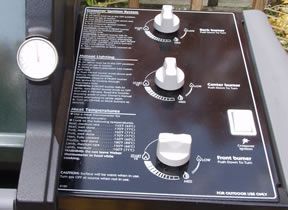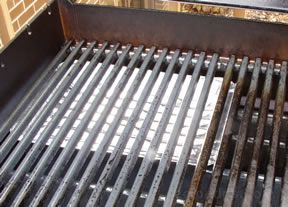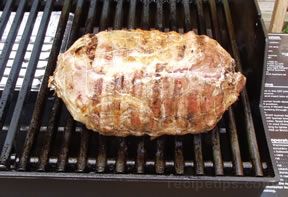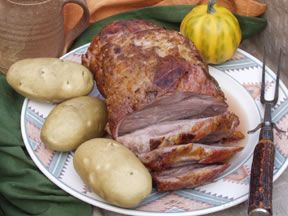|
Grilling is ideal for cooking smaller pork cuts, such as chops, steaks, ham slices, tenderloins, ribs, ground pork patties, sausages, and kabobs. Because grilling uses high heat and short cooking times, it tends to toughen the meat, so it is best to use the most tender cuts available. Lean pork cuts will benefit from marinating before they are grilled.
Pork steaks and pork chops that are going to be grilled should be a minimum of ¾ to 1 inch thick because the high heat will cook the meat quickly. If the cuts are thinner than this, it is easy to overcook the meat, causing it to dry out. The meat must be watched carefully while grilling. Coating the pork with a little oil or marinating it before cooking will help keep it moist. It is important that the grill be properly preheated so that it seals the juices into the meat quickly. The temperature at which the pork is cooked and the distance it is placed from the heat source are both important for providing tender, juicy, properly done pork.
Grilling | Grilling Method & Time | Pork Doneness | Tips
Grilling
Indirect Heat | Direct Heat
The grilling process cooks foods over a high heat source, either directly, indirectly, or a combination of both. Grilling temperatures typically reach as high as 650ºF, but any temperature above 300°F is suitable as a grilling temperature. The high heat of grilling sears the surface of pork, creating meat with a flavorful crust. The required cooking temperature and the method of grilling (direct, indirect, or a combination) depends on the cut of pork and the quality of the meat. Because pork today is raised to be very lean, it is important it is not overcooked in order to produce the best results.
There are many different types of grills available today that can be used when grilling pork. For information on the different types of grills, see Types of Grills. It is important that the grill is set up properly and reaches the appropriate temperature for the cut of pork that is being grilled to ensure that it produces in a juicy, tender finished product that is cooked to the proper doneness. For information on setting up a charcoal or gas grill, see Outdoor Grill Preparation.
When grilling, pork should be cooked at a medium heat. For information on checking the temperature of the grill, see Estimating Heat Level.. The thicker the cut the farther away from the heat source it should be or the heat source should be at a lower temperature to prevent the outside of the cut from burning before the inside is properly cooked. You will also have to decide whether you will use direct or indirect heat during the grilling time. Depending on the cut, you may use both. A cut of pork may require direct heat to seal the outside and indirect to allow the cut to cook thoroughly to the center.
Indirect Heat Grilling
Cooking with indirect heat occurs when you use an area of the grill that is not directly over the heat source. Using indirect heat slows the cooking process down, which allows the center of the cut to cook thoroughly without burning the outside. On charcoal grills, coals are pushed to one side of the grill or banked into a ring around the outer edges. On gas grills, the side of the burner, which is below the area where the food will be placed, is turned off after the grill is preheated. Using one of the indirect setups will provide an area on the grill that is a low heat source. The meat is placed over the area in which there are no coals or over the burner that is turned off on a gas grill. Indirect heat is good for cooking larger cuts of meat, such as roasts, ribs and ham.
|
Indirect Heat Grilling on Charcoal Grills
Once the meat is prepared and the charcoals have been heated properly (see Charcoal Grill Setup), there are several easy steps to follow in order to cook pork with indirect heat on a charcoal grill. |
- There are different setups that can be used for indirect grilling on the charcoal grill. The coals can be pushed to one side of the grill and a pan placed on the opposite side. The pan is used to catch the fat as it melts and drips from the meat while cooking. This will help reduce flare-ups.
|
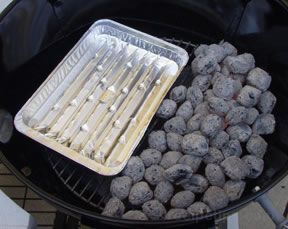
|
- An alternative method for arranging coals for indirect heat grilling is to place half the coals on one side of the grill and the other half on the opposite side. Some charcoal grills are equipped with side baskets, which can be used for this purpose. A drip pan is placed between the coals in the location where the meat will be cooked.
|
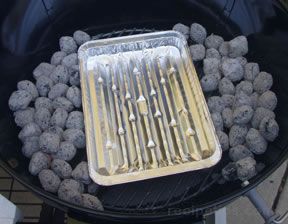
|
- A third method of arranging the coals is to bank them into a ring around the outer edges. Again, a drip pan is placed in the middle of the coals and when the grate is placed on the grill, this is the area the meat will be placed on the grate.
- When using any of the indirect methods, the pork is generally cooked with the cover on the grill.
|

|
- Any of the indirect charcoal grill setups provide an area on the grill, directly above the drip pan and away from the coals, that creates the indirect heat area. The meat is generally seared directly over the coals first and then moved to the indirect heat area to finish cooking
|
Direct Heat Grilling
Cooking with direct heat occurs when you cook the meat directly over the heat source. The meat is cooked quickly over medium or high heat coals or over burners set to medium or high heat on a gas grill. Direct heat is used when grilling food that cooks in 30 or less minutes, such as chops, steaks, ham slices, ground patties, and precooked sausages. Fresh sausages should be poached to precook before grilling or they should be grilled using indirect heat.
| Direct Heat Grilling on Charcoal Grills |
- When using direct heat on a charcoal grill, the coals are generally spread in an even layer on the bottom of the grill to provide a consistently hot, even temperature under the entire cooking surface. It is beneficial to leave a small area along the edge where there are no coals. This provides a section where food can be moved if a flare up occurs while the meat is being cooked.
|

|
- To help prevent the meat from sticking to the grate on which it will be placed, brush the grate with oil and preheat the grill before placing the meat on the grate. The grill should be heated to a medium heat (see Grill Temperatures).
|
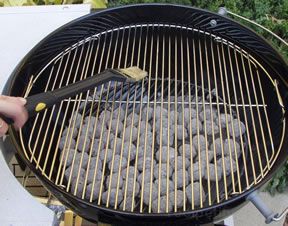
|
- The cooking temperature typically reaches 450ºF to 650ºF when grilling over direct heat. Thin cuts of meat are quickly grilled over such high temperatures, so check often and watch carefully for visual signs of doneness. It is generally suggested to turn the cuts only once.
|
| Direct Heat Grilling on Gas Grills |
- When grilling pork with direct heat on a gas grill, all of the burners are turned on to provide a uniform temperature under the entire cooking surface (grate).
|
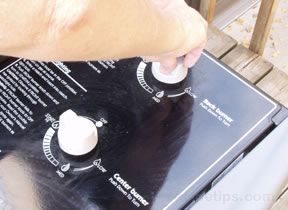
|
- Pork chops work well for direct heat grilling. While the grill is preheating, brush the surface of the chops with oil to help prevent them from sticking to the grate.
|
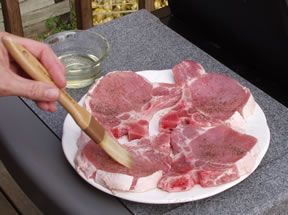
|
- It is also beneficial to brush oil on the grates before placing the food on them to help prevent sticking.
|

|
- Place the chops on the oiled grate once the grill has preheated to the proper temperature (see Grill Temperatures). Place the chops so that they are evenly space and not touching each other. Also, do not overcrowd the grate with too much food so if flare-ups occur from the drippings, there is room to move pieces out of the way of the flames.
|

|
- The meat is generally cooked with the hood down and is turned once during the cooking process. The meat is cooked quickly over burners set on medium to high heat.
|
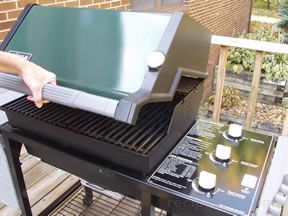
|
- Thin chops, under ¾ inch thick, should be cooked over high heat for only 2 or 3 minutes per side and watched carefully to prevent overcooking. When grilling chops, use tongs or a spatula to turn the meat. A fork should not be used because it will pierce the meat, allowing juices to escape.
|
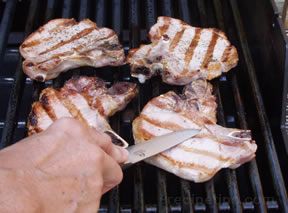
|
- While the meat is cooking, be sure to watch the pieces carefully, turning when one side is nicely browned. It is generally suggested to turn the cuts only once. The second side may not brown as much as the first before the chops are done.
|
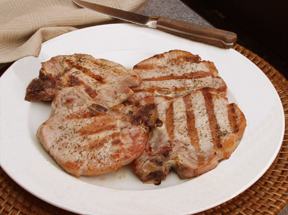
|
- Check for doneness after 2 minutes of cooking on the second side to prevent overcooking. Chops should be removed when they are cut into and the inside is still slightly pink. They will continue to cook when removed from the heat source and allowed to rest.
- Use the chart below for a quick reference for grilling methods and times when grilling chicken.
|
| Type of Pork |
Grilling
Method |
Grilling Time |
Heat Level |
Chops
3/4-inch |
Direct |
3-4 minutes each side |
Medium doneness. For medium well, add approximately 3 minutes per side. |
Chops
1-inch |
Direct |
4-5 minutes each side |
Medium doneness. For medium well, add approximately 3 minutes per side. |
Ham Steak
1-inch,
pre-cooked |
Direct/Indirect |
Direct: 2-4 minutes each side
Indirect: 5-7 minutes each side |
Either Direct or Indirect can be used for pre-cooked ham steak. Direct is quicker but Indirect will give more of a grill taste. |
Ham,
pre-cooked, boneless, 1 lb. |
Indirect |
55-60 minutes |
 |
Ham,
whole w/bone
8-12 lbs. |
Indirect |
1¾-2¾ hours |
 |
Kabobs
1-1½ inch cubed |
Direct |
13-20 minutes (rotate as appropriate) |
Grill 5-6 inches from Direct fire, or sear and continue with Indirect fire until done. |
| Ribs |
Indirect |
50 minutes - 1½ hours |
 |
| Roast |
Indirect |
50 minutes -
2 hours |
 |
| Sausage/Brats |
Direct/Indirect |
15-30 minutes |
Sear with Direct heating, continue with Indirect fire until done. To be safe, bring brats to a boil and simmer for 5-10 minutes before placing on grill. |
For more information on chicken, see Meat - Pork.
Pork Doneness
There are several manners in which pork can be checked for doneness. While some methods are more accurate than others, there are certain cuts for which some methods will not be suitable. Shown below are the most common methods for checking doneness.
Thermometer: Using a thermometer is the most accurate method for testing doneness. A regular meat thermometer is inserted before placing the meat on the grill and it remains there throughout the cooking time. An instant read thermometer is used to check for the proper temperature once the meat has been cooked. The meat is removed from the grill and the instant read thermometer is inserted into the thickest part of the meat to provide a temperature reading in approximately 15 seconds.
|
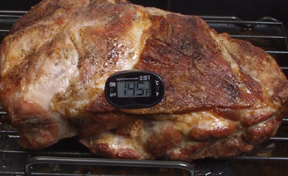
|
|
When checking doneness, remove the meat from grill as it reaches an internal temperature that is 5 to 10 degrees lower than the desired doneness temperature for that cut. The meat should rest for 10 to 15 minutes before serving or carving. During the standing time it will continue to cook and the temperature should rise to the appropriate internal temperature. |
This will ensure that the meat will not be overcooked. Smaller cuts such as chops, steaks and cutlets can be left to stand for a shorter period of time, approximately 3 to 5 minutes. |
A meat thermometer will not work for checking doneness of some pork cuts. Cuts such as bacon, ribs, pork patties, cubes, and strips would not be able to have doneness checked by the use of a thermometer. Other methods of checking doneness would have to be used. Thinner cuts of chops and steaks are also difficult to check with a thermometer, but if thick enough, it can be inserted from the side into the middle of the chop to get an internal reading. |
| Note: When either type of thermometer is inserted into the meat, it must not be touching a bone or it will result in an inaccurate reading. |
| Internal Temperatures for Proper Doneness |
| Roasts - Bone in or boneless |
145°F |
| Tenderloin |
145°F |
| Fresh Hams |
145° - 155°F |
| Whole Leg or Half Leg |
145° - 155°F |
| Smoked Whole or Half Ham |
145°F |
| Smoked and Fully Cooked Ham |
130° - 140°F |
| Chops and Steaks - 1 inch or thicker |
145°F |
|
Note: If the proper temperature is not reached the meat should be returned to the grill for further cooking. |
Piercing: Another method for testing doneness is to prick the cut of pork with a fork or the tip of a knife and check to see if the juices that escape run clear. If the juices are clear or have just a very faint pink tint, the meat is done. If the juices are not clear, the meat should be returned to the grill for further cooking.
Visual: The visual method of determining doneness works best on smaller cuts of pork such as thin chops, steaks, cutlets, and medallions. Make a small slit with the tip of a knife into the thickest or center part of the cut and then pry the slit open. The meat will be opaque and have a slight pinkish tint if it is properly done to provide a juicy and tender piece. If the meat shows any signs of not being done, it should be returned to the heat source for further cooking.
Some smaller cuts of pork can only be checked for doneness by visually looking at them while they are being cooked. Cuts such as sliced bacon and pork strips are browned to desired doneness, but suggested cooking times should be followed to avoid overcooking. Ground pork should be cooked until it no longer shows any pink coloring.
Touch: Cuts such as chops, steaks, ham slices and medallions can be tested for doneness by touch. When pressed with tongs or a fingertip, the cut should feel firm but easily spring back to shape. Some juices may be released, which should be clear or have only a faint tint of pink coloring. Meat that is not done will feel soft and will release darker pink juices. A well-done cut will feel fairly firm when touched and will release little or no juices.
Grilling Tips
- Preheat grill to the proper temperature to ensure the meat surface is seared quickly to give it a flavorful crust.
- To prevent the meat from sticking, use clean racks and coat them with vegetable oil or a nonstick vegetable oil spray.
- To keep chops, steaks and ham slices flat while grilling, clip the fat and rind around the edges at 1 to 1 ½ inch intervals.
- When grilling, aromatic woods such as hickory, mesquite, apple, or cherry can be added to the preheated coals to give the meat a distinctive flavor.
- Do not use a fork to turn the pork cuts as they cook. The piercing causes juices to escape. Use tongs to turn.
- Leave an area in the charcoal grill without coals so that if a flare up occurs or some of the meat is cooking too fast, you can move the meat to this cooler area. On a gas grill, leave one burner on low.
|













